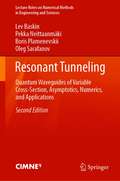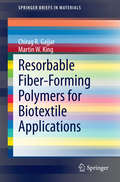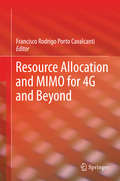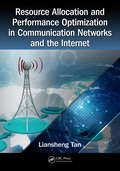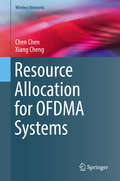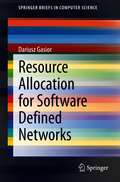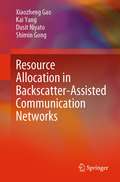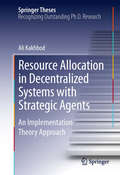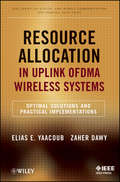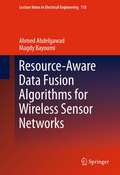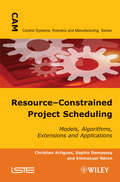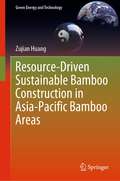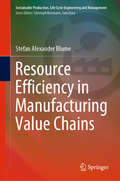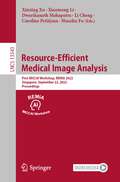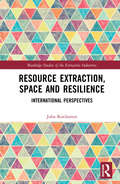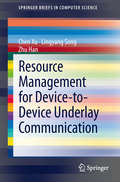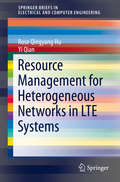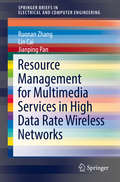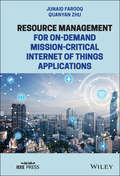- Table View
- List View
Resonant Tunneling: Quantum Waveguides of Variable Cross-Section, Asymptotics, Numerics, and Applications (Lecture Notes on Numerical Methods in Engineering and Sciences)
by Lev Baskin Pekka Neittaanmäki Boris Plamenevskii Oleg SarafanovThis book studies electron resonant tunneling in two- and three-dimensional quantum waveguides of variable cross-sections in the time-independent approach. Mathematical models are suggested for the resonant tunneling and develop asymptotic and numerical approaches for investigating the models. Also, schemes are presented for several electronics devices based on the phenomenon of resonant tunneling. Compared to its first edition, this book includes four new chapters, redistributes the content between chapters and modifies the estimates of the remainders in the asymptotics of resonant tunneling characteristics. The book is addressed to mathematicians, physicists, and engineers interested in waveguide theory and its applications in electronics.
Resorbable Fiber-Forming Polymers for Biotextile Applications
by Chirag R. Gajjar Martin W. KingThis book summarizes the properties and applications of conventional and commercially available fiber-forming, bioresorbable polymers, as well as those currently under study, for use as biotextiles. Factors affecting the performance of these biomaterials are presented, and precautionary measures to reduce premature, hydrolytic degradation during manufacturing and processing are discussed. Because of the structural requirements of medical devices and the technological advancements in synthetic fibers and textile technology, the new field of "Biotextiles" has evolved to exploit the potential of various woven, knitted, braided and non-woven textile structures for biomedical applications. Textile substrates provide certain unique mechanical properties to the medical device and because of an inherently high level of porosity, they can encourage cell growth and promote migration and proliferation. Bioresorbable devices that assist in the repair and regeneration of damaged tissues have in recent years replaced many of the permanent prosthetic devices. Thus, the topic of "Bioresorbable Biomaterials" generates much interest and research activity in the field of biomaterials science today. For this reason, the use of bioresorbable polymers as fibers is currently dominating the field of resorbable biomaterials for applications from sutures to tissue engineering scaffolds.
Resource Allocation and MIMO for 4G and Beyond
by Francisco Rodrigo Porto CavalcantiThis book will be a comprehensive collection of advanced concepts related to 4th generation wireless communication systems. It will be divided into two main parts: resource allocation and transceiver architectures. These two research areas are at the core of the recent advances experimented by wireless communication systems. Each chapter will cover a relevant, timely, topic with two focuses: a first part which is of tutorial and survey nature, reviews the state of the art in that topic, followed by a more deep treatment including current research topics, case studies and performance analysis.
Resource Allocation and Performance Optimization in Communication Networks and the Internet
by Liansheng TanThis book provides a comprehensive introduction to the underlying theory, design techniques and analytical results of wireless communication networks, focusing on the core principles of wireless network design. It elaborates the network utility maximization (NUM) theory with applications in resource allocation of wireless networks, with a central aim of design and the QoS guarantee. <P><P> It presents and discusses state-of-the-art developments in resource allocation and performance optimization in wireless communication networks. It provides an overview of the general background including the basic wireless communication networks and the relevant protocols, architectures, methods and algorithms.
Resource Allocation for OFDMA Systems (Wireless Networks)
by Chen Chen Xiang ChengThis book introduces the sources and historic collection campaigns of resource allocation in wireless communication systems. The unique characteristics of MIMO-OFDMA systems are thoroughly studied and summarized. Remarks on resource allocation and spectrum sharing are also presented, which demonstrate the great value of resource allocation techniques, but also introduce distinct challenges of resource allocation in MIMO-OFDMA systems. Novel resource allocation techniques for OFDMA Systems are surveyed from various applications (e.g., for unicast, or multicast with Guaranteed BER and Rate, subcarrier and power allocation with various detectors, low-complexity energyefficient resource allocation, etc.) in this book.Due to the high mobility and low latency requirements of 5G wireless communications, this book discusses how to deal with the imperfect CSI. It also discusses how to deal with e.g., throughput maximization, outage probabilities maximization and guarantee, energy efficiency, physical-layer security issues with feedback channel capacity constraints, in order to characterize and understand the applications of practical scenes.This book will target professionals & researchers working in the fields of Wireless Communications and Networking, Resource Allocation and Transmissions. Advanced-level students in electrical engineering and computer science will also find this book useful as a secondary textbook.
Resource Allocation for Software Defined Networks (SpringerBriefs in Computer Science)
by Dariusz GasiorThe book is devoted to the selected resource allocation problems in Software- Defined Networks. Moreover, it covers results concerning Software Defined Wide Area Networks (SD-WANs) which is one of the current networking hot topics. The variety of different cases is considered including virtualization and information-centric paradigm. For each case, the mathematical model together with the problem formulation is given and some solution algorithms are proposed. The algorithms are discussed and evaluated, mostly with simulations.
Resource Allocation in Backscatter-Assisted Communication Networks
by Xiaozheng Gao Kai Yang Dusit Niyato Shimin GongThis book investigates the resource allocation in backscatter-assisted communication networks. With the development of backscatter communications, integrating backscatter communication technology into traditional communication networks can improve the network performance significantly. To fully improve the performance of backscatter-assisted communication networks, resource allocation is of special importance. It is worth to mention that the resource allocation in backscatter-assisted communication networks is more challenging than that in traditional communication networks, and the tradeoff of the performance between backscatter communications and traditional communications needs to be carefully considered. In this book, considering that game theory is an attractive tool for developing and analyzing distributed, flexible, and autonomous networks, we develop the auction-based time scheduling schemes, contract-based time assignment scheme, and evolutionary game-based access point and service selection scheme for the backscatter-assisted radio-frequency-powered cognitive networks, where some important properties such as individual rationality are considered. We also employ the optimization approach and develop a relay mode selection and resource sharing scheme for backscatter-assisted hybrid relay networks to improve the throughput. We believe that the developed resource allocation schemes in this book can provide useful guidance for the design of backscatter-assisted communication networks and future Internet of Things. Graduate students, researchers, and engineers in the field of communication networks can benefit from the book.
Resource Allocation in Decentralized Systems with Strategic Agents
by Ali KakhbodThis thesis presents a significant contribution to decentralized resource allocation problems with strategic agents. The study focused on three classes of problems arising in communication networks. (C1). Unicast service provisioning in wired networks. (C2). Multi-rate multicast service provisioning in wired networks. (C3). Power allocation and spectrum sharing in multi-user multi-channel wireless communication systems. Problems in (C1) are market problems; problems in (C2) are a combination of markets and public goods; problems in (C3) are public goods. Dr. Kakhbod developed game forms/mechanisms for unicast and multi-rate multicast service provisioning that possess specific properties. First, the allocations corresponding to all Nash equilibria (NE) of the games induced by the mechanisms are optimal solutions of the corresponding centralized allocation problems, where the objective is the maximization of the sum of the agents' utilities. Second, the strategic agents voluntarily participate in the allocation process. Third, the budget is balanced at the allocations corresponding to all NE of the game induced by the mechanism as well as at all other feasible allocations. For the power allocation and spectrum sharing problem, he developed a game form that possesses the second and third properties as detailed above along with a fourth property: the allocations corresponding to all NE of the game induced by the mechanism are Pareto optimal. The thesis contributes to the state of the art of mechanism design theory. In particular, designing efficient mechanisms for the class of problems that are a combination of markets and public goods, for the first time, have been addressed in this thesis. The exposition, although highly rigorous and technical, is elegant and insightful which makes this thesis work easily accessible to those just entering this field and will also be much appreciated by experts in the field.
Resource Allocation in Network Function Virtualization: Problems, Models and Algorithms
by Song Yang Nan He Fan Li Xiaoming FuNetwork Function Virtualization (NFV) has recently attracted considerable attention from both research and industrial communities. Numerous papers have been published regarding solving the resource- allocation problems in NFV, from various perspectives, considering different constraints, and adopting a range of techniques. However, it is difficult to get a clear impression of how to understand and classify different kinds of resource allocation problems in NFV and how to design solutions to solve these problems efficiently.This book addresses these concerns by offering a comprehensive overview and explanation of different resource allocation problems in NFV and presenting efficient solutions to solve them. It covers resource allocation problems in NFV, including an introduction to NFV and QoS parameters modelling as well as related problem definition, formulation and the respective state-of-the-art algorithms.This book allows readers to gain a comprehensive understanding of and deep insights into the resource allocation problems in NFV. It does so by exploring (1) the working principle and architecture of NFV, (2) how to model the Quality of Service (QoS) parameters in NFV services, (3) definition, formulation and analysis of different kinds of resource allocation problems in various NFV scenarios, (4) solutions for solving the resource allocation problem in NFV, and (5) possible future work in the respective area.
Resource Allocation in Uplink OFDMA Wireless Systems: Optimal Solutions and Practical Implementations (IEEE Series on Digital & Mobile Communication #24)
by Elias Yaacoub Zaher DawyTackling problems from the least complicated to the most, Resource Allocation in Uplink OFDMA Wireless Systems provides readers with a comprehensive look at resource allocation and scheduling techniques (for both single and multi-cell deployments) in uplink OFDMA wireless networks—relying on convex optimization and game theory to thoroughly analyze performance. Inside, readers will find topics and discussions on: Formulating and solving the uplink ergodic sum-rate maximization problem Proposing suboptimal algorithms that achieve a close performance to the optimal case at a considerably reduced complexity and lead to fairness when the appropriate utility is used Investigating the performance and extensions of the proposed suboptimal algorithms in a distributed base station scenario Studying distributed resource allocation where users take part in the scheduling process, and considering scenarios with and without user collaboration Formulating the sum-rate maximization problem in a multi-cell scenario, and proposing efficient centralized and distributed algorithms for intercell interference mitigation Discussing the applicability of the proposed techniques to state-of-the-art wireless technologies, LTE and WiMAX, and proposing relevant extensions Along with schematics and figures featuring simulation results, Resource Allocation in Uplink OFDMA Wireless Systems is a valuable book for?wireless communications and cellular systems professionals and students.
Resource and Environmental Management
by Bruce MitchellThis book does an exceptional job in giving an understanding of change, complexity, uncertainty and conflict as well as their linkages, including awareness of strategies, methods and techniques to handle them relative to resource and environmental management. The text enhances the reader's capacity to conduct practice and conduct research in resource and environmental management.
Resource-Aware Data Fusion Algorithms for Wireless Sensor Networks
by Magdy Bayoumi Ahmed AbdelgawadThis book introduces resource-aware data fusion algorithms to gather and combine data from multiple sources (e.g., sensors) in order to achieve inferences. These techniques can be used in centralized and distributed systems to overcome sensor failure, technological limitation, and spatial and temporal coverage problems. The algorithms described in this book are evaluated with simulation and experimental results to show they will maintain data integrity and make data useful and informative. Describes techniques to overcome real problems posed by wireless sensor networks deployed in circumstances that might interfere with measurements provided, such as strong variations of pressure, temperature, radiation, and electromagnetic noise; Uses simulation and experimental results to evaluate algorithms presented and includes real test-bed; Includes case study implementing data fusion algorithms on a remote monitoring framework for sand production in oil pipelines.
Resource-Constrained Project Scheduling: Models, Algorithms, Extensions and Applications (Wiley-iste Ser.)
by Sophie Demassey Emmanuel Néron Christian ArtiguesThis title presents a large variety of models and algorithms dedicated to the resource-constrained project scheduling problem (RCPSP), which aims at scheduling at minimal duration a set of activities subject to precedence constraints and limited resource availabilities. In the first part, the standard variant of RCPSP is presented and analyzed as a combinatorial optimization problem. Constraint programming and integer linear programming formulations are given. Relaxations based on these formulations and also on related scheduling problems are presented. Exact methods and heuristics are surveyed. Computational experiments, aiming at providing an empirical insight on the difficulty of the problem, are provided. The second part of the book focuses on several other variants of the RCPSP and on their solution methods. Each variant takes account of real-life characteristics which are not considered in the standard version, such as possible interruptions of activities, production and consumption of resources, cost-based approaches and uncertainty considerations. The last part presents industrial case studies where the RCPSP plays a central part. Applications are presented in various domains such as assembly shop and rolling ingots production scheduling, project management in information technology companies and instruction scheduling for VLIW processor architectures.
Resource Discovery, Navigability and Trust Management Techniques for IoT and SIoT
by Venugopal K R Roopa M S Santosh PattarA ready reference for the next-generation discovery techniques, this book presents advanced research findings on resource discovery, network navigability, and trust management on the Internet of Things (IoT) and Social Internet of Things (SIoT) ecosystems. It discusses the benefits of integrating social networking concepts into the Internet of Things to find the preferable, reliable, scalable, and near-optimal detection of things or services. It explores the concepts of the Social Internet of Things in different domains of IoT, such as the Internet of Vehicles and the Industrial Internet of Things. This book works to recognize and respond to user queries and improve service provisioning, find the optimal solution for the link selection in the SIoT structure, develop large-scale platforms, and provide a smart mechanism for trust evaluation.· Covers the rapid advancements in low-cost sensor manufacturing, communication protocols, embedded systems, actuators, and hardware miniaturization that have contributed to the exponential growth of the IoT· Presents the fundamentals of a search system for sensor search and resource discovery in an IoT ecosystem· Includes the applicability of different search techniques across several application domains of the IoT under various use case scenarios· Discusses the thrust areas in SIoT (service discovery and composition, network navigability, relationship management, and trustworthiness management) and presents several prerequisites, challenges, and use case scenarios· Provides insights into current challenges in the domains of Internet of Things and Social Internet of ThingsThis book will be helpful to researchers, scholars, and postgraduate students in Computer Science and Information Technology departments.
Resource-Driven Sustainable Bamboo Construction in Asia-Pacific Bamboo Areas (Green Energy and Technology)
by Zujian HuangThis book presents the new approach of resource-driven bamboo construction (RDBC), developing a clear assessment framework and operational solution to improve the value of resources and the sustainability of bamboo constructions. The book discusses how to carry out research on basic parameters and life cycle assessment, as well demonstrating the approach in practice. This book develops a sustainability assessment model for bamboo construction in Asia-Pacific bamboo areas to measure the effects and success of RDBC. It solves issues related to environmental impact, energy consumption, land cost, indoor comfort, construction durability, and sustainable material application of the bamboo constructions. It utilizes digital tools to perform statistical analysis on large sample conditions, enabling the method to be better implemented, and presents case studies of RDBC method in action. The large amount of data collected, method guidance, and demonstrations provide a comprehensive reference for those wishing to apply bamboo in the building industry. This book is particularly relevant to scientists, professionals, architects, civil engineers, and students who are interested in bamboo material and its application in building industry. It provides readers with a new perspective of the high-value utilization of bamboo forest resources and methods to achieve sustainable bamboo construction.
Resource Efficiency in Manufacturing Value Chains (Sustainable Production, Life Cycle Engineering and Management)
by Stefan Alexander BlumeThis book presents a concept for fostering resource efficient manufacturing. The protection of our environment demands a more responsible use of natural resources, and a higher degree of transparency along manufacturing value chains will be required in order to make significant advances in this context. Industrial decision makers must be provided with adequate methods and tools to simultaneously and systematically pursue technical, economic and environmental targets. Building on established and complementary methods, such as material and energy flow analysis (MEFA), value stream mapping (VSM), life cycle costing (LCC) and environmental life cycle assessment (LCA), this book introduces a concept that allows a holistic modeling and multi-dimensional performance assessment of manufacturing systems on different levels – from processes up to entire value chains and product life cycles. It also demonstrates the application of the concept using two case studies from the metal mechanic industry.
Resource Efficiency in Manufacturing Value Chains (Sustainable Production, Life Cycle Engineering and Management)
by Stefan Alexander BlumeThis book presents a concept for fostering resource efficient manufacturing. The protection of our environment demands a more responsible use of natural resources, and a higher degree of transparency along manufacturing value chains will be required in order to make significant advances in this context. Industrial decision makers must be provided with adequate methods and tools to simultaneously and systematically pursue technical, economic and environmental targets. Building on established and complementary methods, such as material and energy flow analysis (MEFA), value stream mapping (VSM), life cycle costing (LCC) and environmental life cycle assessment (LCA), this book introduces a concept that allows a holistic modeling and multi-dimensional performance assessment of manufacturing systems on different levels – from processes up to entire value chains and product life cycles. It also demonstrates the application of the concept using two case studies from the metal mechanic industry.
Resource-Efficient Medical Image Analysis: First MICCAI Workshop, REMIA 2022, Singapore, September 22, 2022, Proceedings (Lecture Notes in Computer Science #13543)
by Xinxing Xu Xiaomeng Li Dwarikanath Mahapatra Li Cheng Caroline Petitjean Huazhu FuThis book constitutes the refereed proceedings of the first MICCAI Workshop on Resource-Efficient Medical Image Analysis, REMIA 2022, held in conjunction with MICCAI 2022, in September 2022 as a hybrid event. REMIA 2022 accepted 13 papers from the 19 submissions received. The workshop aims at creating a discussion on the issues for practical applications of medical imaging systems with data, label and hardware limitations.
Resource Extraction, Space and Resilience: International Perspectives (Routledge Studies of the Extractive Industries and Sustainable Development)
by Juha KotilainenWhile much of the current research on the extractive industries and their socio-environmental impacts is region specific, Resource Extraction, Space and Resilience: International Perspectives critically explores the current state of the extractive industries sector from a uniquely global perspective. The book introduces a more dynamic idea of sustainability in evaluating mineral extraction and its impacts, and provides a spatialized understanding of the evolution of the extractive industries to help visualise the interlinkages across space, regions and scales. Professor Kotilainen responds to these theoretical challenges by analysing the potential for resilience of mining activities from multiple perspectives across scales, exploring why it is only possible to achieve temporary balance and stability for the whole resource extraction system. Taking a global perspective, the book explores the interlinkages of the industry, investigates the similarities and differences in how the industry operates and examines the social and environmental impacts it has. By providing an explicitly theoretically informed analysis of the state of the extractive industries, this text will appeal to a wide range of scholars with an interdisciplinary interest in the extractive industries and natural resource management, including human geographers and social scientists with a focus on the relations of humans and societies with their physical environments.
Resource Guide for Food Writers
by Gary AllenFirst published in 1999. Routledge is an imprint of Taylor and Francis, an informa company.
The Resource Handbook of Electronics (Electronics Handbook Series)
by Jerry C. WhitakerBuilding upon the extensive resources of Whitaker's The Electronics Handbook, The Resource Handbook of Electronics offers the most complete collection of reference and tabular data available. It provides the data that engineers and technologists need in a clear, concise format that does away with detailed explanations and presents just the facts-the essential tables, charts, formulas, definitions, and equations with just enough detail to accomplish the task at hand.This one-stop reference covers a broad range of technologies, emphasizes practical applications, and provides references to more detailed information on important subjects. Its many topics include:
Resource Management for Device-to-Device Underlay Communication
by Chen Xu Zhu Han Lingyang SongDevice-to-Device (D2D) communication will become a key feature supported by next generation cellular networks, a topic of enormous importance to modern communication. Currently, D2D serves as an underlay to the cellular network as a means to increase spectral efficiency. Although D2D communication brings large benefits in terms of system capacity, it also causes interference as well as increased computation complexity to cellular networks as a result of spectrum sharing. Thus, efficient resource management must be performed to guarantee a target performance level of cellular communication. This brief presents the state-of-the-art research on resource management for D2D communication underlaying cellular networks. Those who work with D2D communication will use this book's information to help ensure their work is as efficient as possible. Along with the survey of existing work, this book also includes the fundamental theories, key techniques, and applications.
Resource Management for Heterogeneous Networks in LTE Systems
by Rose Qingyang Hu Yi QianThis SpringerBrief provides an in-depth look at the key issues that affect the performance of heterogeneous networks and presents schemes that can effectively tackle these issues. In particular, this book discusses unbalanced traffic load among the macro and micro Base Stations (BSs) caused by the transmit power disparity, and a load-balancing based mobile association scheme to balance the traffic load among the macro and micro BSs. This book also introduces a fractional frequency reuse (FFR) scheme with proper power control to help reduce interference at the UEs which are most vulnerable to such intra-cell interference. The last section investigates radio resource allocation issues for heterogeneous networks with cooperative relays, and proposes a resource allocation framework that could achieve proportional fairness among the UEs. Numerical results are provided to demonstrate the effectiveness of the proposed solutions in tackling the problem and improving network performance. Resource Management for Heterogeneous Networks in LTE-A Systems is designed for researchers and professionals working in networking and resource management. The content is also valuable for advanced-level students in computer science and electrical engineering.
Resource Management for Multimedia Services in High Data Rate Wireless Networks
by Ruonan Zhang Lin Cai Jianping PanThis brief offers a valuable resource on principles of quality-of-service (QoS) provisioning and the related link-layer resource management techniques for high data-rate wireless networks. The primary emphasis is on protocol modeling and analysis. It introduces media access control (MAC) protocols, standards of wireless local area networks (WLANs), wireless personal area networks (WPANs), and wireless body area networks (WBANs), discussing their key technologies, applications, and deployment scenarios. The main analytical approaches and models for performance analysis of the fundamental resource scheduling mechanisms, including the contention-based, reservation-based, and hybrid MAC, are presented. To help readers understand and evaluate system performance, the brief contains a range of simulation results. In addition, a thorough bibliography provides an additional tool. This brief is an essential resource for engineers, researchers, students, and users of wireless networks.
Resource Management for On-Demand Mission-Critical Internet of Things Applications (IEEE Press)
by Junaid Farooq Quanyan ZhuRESOURCE MANAGEMENT FOR ON-DEMAND MISSION-CRITICAL INTERNET OF THINGS APPLICATIONS Discover an insightful and up-to-date treatment of resource management in Internet of Things technology In Resource Management for On-Demand Mission-Critical Internet of Things Applications, an expert team of engineers delivers an insightful analytical perspective on modeling and decision support for mission-critical Internet of Things applications. The authors dissect the complex IoT ecosystem and provide a cross-layer perspective on the design and operation of IoT, especially in the context of smart and connected communities. The book offers an economic perspective on resource management in IoT systems with a particular emphasis on three main areas: spectrum management via reservation, allocation of cloud/fog resources to IoT applications, and resource provisioning to smart city service requests. It leverages theories from dynamic mechanism design, optimal control theory, and spatial point processes, providing an overview of integrated decision-making frameworks. Finally, the authors discuss future directions and relevant problems on the economics of resource management from new perspectives, like security and resilience. Readers will also enjoy the inclusion of: A thorough introduction and overview of IoT applications in smart cities, mission critical IoT services and requirements, and key metrics and research challenges A comprehensive exploration of the allocation of spectrum resources to mission critical IoT applications, including the massive surge of IoT and spectrum scarcity problem Practical discussions of the provisioning of cloud/fog computing resources to IoT applications, including allocation policy In-depth examinations of resource provisioning to spatio-temporal service requests in smart cities Perfect for engineers working on Internet of Things and cyber-physical systems, Resource Management for On-Demand Mission-Critical Internet of Things Applications is also an indispensable reference for graduate students, researchers, and professors with an interest in IoT resource management.
